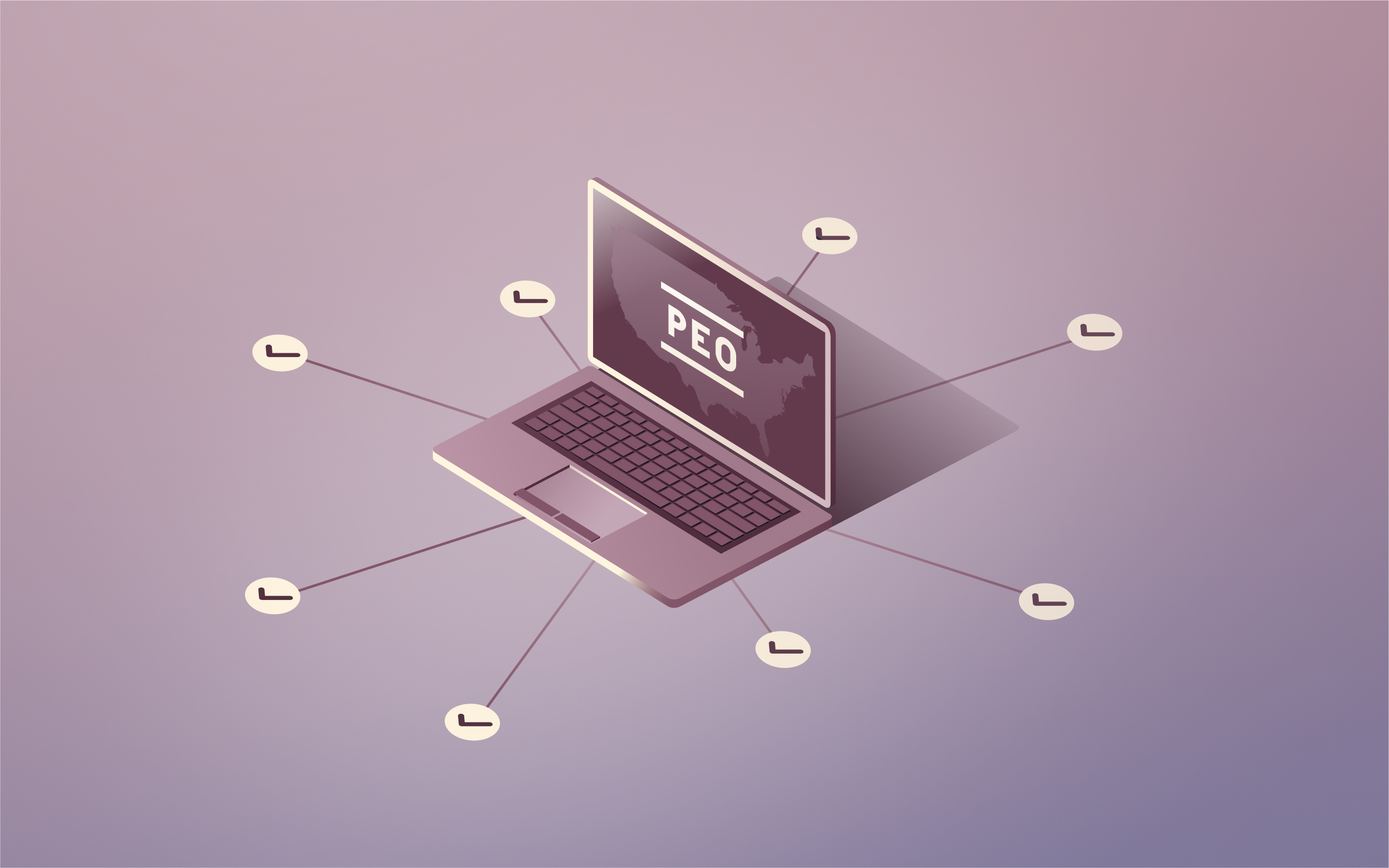The best 7 PEO HR solutions

A professional employer organization (PEO) partners with your business to provide HR support with administrative tasks like payroll, benefits, and compliance. By removing the busy work from human resources, a PEO frees valuable time and resources for your people operations professionals to focus on strategic work.
Other benefits of working with a PEO include access to better quality benefits and shared compliance risk. Because PEOs operate on a co-employment model, they share liability with your business in specified areas and have a powerful incentive to exercise diligence when it comes to compliance. Their superior size gives them leverage when negotiating benefits packages with insurers, and PEOs typically pass those savings on to their clients.
When do you need a PEO in your company?
A PEO can benefit any organization where the administrative tasks associated with HR have become overwhelming and prevent your people team from engaging in the strategic work needed to grow the business. It’s not a question of size or complexity as much as it is of time. If your HR team spends more time downloading reports or coordinating payroll than thinking of ways to source and retain top talent, for example, it may be time to consider partnering with a PEO.
Other situations where even small businesses with straightforward HR needs can benefit from working with a PEO include rapid headcount increase and geographic expansion. Suddenly having more employees to service can put a strain on smaller HR teams that may or may not have the bandwidth or the manpower to cope with many new hires at once. Similarly, expanding across state lines or national borders comes with new rules, regulations, and policies that may prove too complex to learn and implement in a short period of time.
The top PEO companies in the market
If your organization is considering partnering with a PEO, understanding the features and tools different solutions offer can help you make an informed decision. Not all PEO solutions offer the same functionality, so it’s important to understand your business’ needs when evaluating providers.
1. Rippling
By syncing all of your HR, IT, and finance data across a single, unified platform, Rippling allows you to automate and streamline important HR administrative work like payroll, benefits, worker’s compensation, and onboarding. Over 600 native-built integrations and event-triggered workflows remove the need to navigate across multiple HR platforms to complete important tasks, and automated compliance alerts keep you up to date of important regulatory changes.
Pros
Cons
Consolidated HR data in a single source of truth
Some payroll features limited to the US
Extensive automations and integrations streamline workflows
Requires a custom quote
Library of over 600 third-party integrations
Advanced reporting and analytics
Rippling support comes in the form of talented HR advisors and benefits, including large group health plans, 401(k) plans through an integration with Guideline, HSA, FSA, and commuter flex benefits. Rippling also offers a pay-as-you-go option for workers’ compensation insurance and provides access to EPLI coverage to protect your business.
2. Paychex
Originally a payroll services provider, Paychex expanded its service offering to include PEO, albeit on a limited basis. Businesses looking for a human touch will appreciate the option for an on-site HR manager.
Pros
Cons
Personalized risk assessment
Limited HR capabilities can make scaling difficult
Comprehensive, cost-effective employee benefits
Legacy technology with minimal integrations
High-rated mobile app
Small changes may require redesigning your system from the ground up
While Paychex brings several decades of experience to the PEO game, its growth by acquisition can cause complications. Unlike a natively-built system, Paychex relies on a complicated set of interconnected technologies to provide its services — making one update can require updates across different modules.
3. Deel
For smaller businesses or startups unsure about committing to a PEO service provider, Deel’s straightforward software could be a great way to test the waters. Deel performs particularly well when it comes to payroll administration, with tools for local and global payruns, tax filings and compliance.
Pros
Cons
Supports global and domestic payroll administration
Limited features compared to other PEO services
Free HR tool for companies with fewer than 200 employees
No mobile app
Basic HRIS workflows
Complex interface and limited customer support
That said, Deel’s software-first approach comes with some drawbacks. This PEO provider doesn’t offer a mobile app or a self-serve platform for employees, and support options rely heavily on self-help. There’s no automatic connection to a support specialist, for example. This becomes cause for concern when you consider that the Deel interface comes with a steep learning curve.
4. Justworks
One of the newer players in the PEO space, Justworks receives praise for its clear pricing model designed to scale with your business. Partner businesses have a choice between two plans offering different levels of support, ranging from the basis of HR administration to help with benefits packages.
Pros
Cons
Dedicated self-serve employee portal
No mobile app
Comprehensive payroll services, including off-cycle payroll
Basic features only available as add-ons
Compliance support
Does not manage SUTA accounts for partner businesses
Limited custom report options
If your organization commits to Justworks and later decides to work with another provider, the changeover process may prove painful. There’s no easy toggle-on and toggle-off option, especially when it comes to state unemployment tax compliance. Leaving Justworks means setting up new SUTA accounts in up to 23 states.
5. Papaya Global
Known for its international presence, Papaya Global offers PEO services suitable for businesses with an international presence, including global payroll and compliance. This provider also supports international onboarding and benefits management. For businesses that rely heavily on contractors, Papay Global offers a PEO package specifically for non-employee workers.
Pros
Cons
Strong automation tools
Setup process can last up to three months
Self-serve employee portal
Limited integrations
Contractor-only plan
Uses third-party payment providers in most countries
In order to provide services around the world, Papaya Global relies on a network of in-country payment providers to which it outsources payroll functions. This can lead to delays and a lack of transparency if problems arise.
6. ADP TotalSource
One of the oldest providers of payroll administration and other HR services, ADP’s PEO offering, TotalSource, aims to provide comprehensive support that ranges from straightforward payroll to learning management systems to talent acquisition.
Pros
Cons
Extensive library of template reports
Limited automations with no event-based triggers
Learning management system
Complex interface with steep learning curve
Storyboard analytics
Recruitment tools not as comprehensive as some competitors
Comprehensive HR function support across modules
Similar to Paychex, ADP developed its suite of HR software solutions primarily through acquisition rather than in-house development. This can lead to challenges with adoption, as employees will need to master different interfaces and tools to benefit from all of TotalSource’s features. And while TotalSource does offer automations and custom workflows, they’re not as numerous or powerful as some other PEO solutions.
7. Trinet
Trinet’s PEO offering focuses on providing small and mid-size businesses with access to attractive benefits packages. The platform also offers payroll administration, time and attendance tracking, and automated onboarding support.
Pros
Cons
Self-serve benefits management
Basic HR functionality not suited for complex workflows
Support for payroll, onboarding, and time and attendance
Minimal learning management and task management features
Mobile app
Limited integrations with third-party apps and tools
Many table-stakes features, like payroll management, recruitment, and HR advisory services, aren’t included in basic packages, meaning you’ll pay extra. Trinet also offers basic, but limited, reporting and integrations with third-party apps.
How to choose a PEO provider
When choosing a PEO provider, start by considering the type of support your organization needs. Many PEOs offer an extensive array of services, making it easy to get lost in features and tools that may not actually benefit your company.
Not sure which services your organization needs? Ask the HR team which tasks they find most frustrating or take the most time away from important strategic work..
Payroll capabilities
Payroll administration is one of your business’ most important responsibilities. Not only does late or inaccurate pay lead to stress for your employees, but failure to properly report, withhold, and deposit payroll taxes can lead to penalties from the IRS.
A PEO that manages all aspects of payroll administration, from scheduling payruns to completing the required Form 941 or Form 944, can remove a significant administrative burden from your HR team.
Management of employees benefits
Small and midsize businesses sometimes struggle when negotiating employee benefits packages due to their size and lack of comparative bargaining power. The result? Employees pay more for less comprehensive health coverage or fewer savings options.
PEOs, which partner with multiple organizations, have greater negotiating power with insurers and other providers. This means richer benefits for your employees at a lower cost.
Number of employees
The size of your headcount can also have cost implications. Some PEOs charge a flat annual or monthly fee based on the size of your payroll, but others charge a per-employee fee.
Why Rippling PEO is your best choice
A comprehensive, single-system solution, Rippling PEO offers support to businesses of all sizes worldwide. Rippling’s integrated HCM removes barriers between key HR functions, including payroll, benefits management, headcount planning, and learning management, for a seamless experience.
- Consolidated platform unifies all of your employee data into a single source of truth
- Powerful custom reporting and analytics tools
- Automated compliance alerts with suggested action plans
- Remote team management features, including digital onboarding, tax registration, and device management
- Quality employee benefits plans at competitive prices
Frequently asked questions
What is a PEO?
A PEO, which stands for ‘professional employer organization’ provides HR support with tasks such as payroll administration, regulatory compliance, benefits administration, and tax filings. The PEO may enter into a co-employment relationship with a business, which can mean access to certain benefits and shared risks. Small and mid-sized organizations partner with PEOs to reduce the administrative burden and expense associated with specific HR tasks.
What are the differences between Rippling HR Services and a PEO?
A PEO generally uses a co-employment model to provide administrative HR support, sharing responsibilities and risk with your organization. Rippling HR Services, can support many of the same tasks but remains entirely separate from your organization with no sharing of liability when it comes to compliance matters. Rippling HR Services tend to offer more flexibility and control, however companies don’t benefit from benefits cost savings the way they can with a PEO.
What is the difference between a PPO and a PEO?
A PEO and a preferred provider network (PPO) serve two very different purposes. A PEO provides support with certain HR tasks, such as payroll, benefits administration, and tax compliance. A PPO is a type of insurance network that allows members to receive services from designated providers without a referral in exchange for higher out of pocket costs.
This blog is based on information available to Rippling as of August 16, 2024.
Disclaimer: Rippling and its affiliates do not provide tax, accounting, or legal advice. This material has been prepared for informational purposes only, and is not intended to provide or be relied on for tax, accounting, or legal advice. You should consult your own tax, accounting, and legal advisors before engaging in any related activities or transactions.









